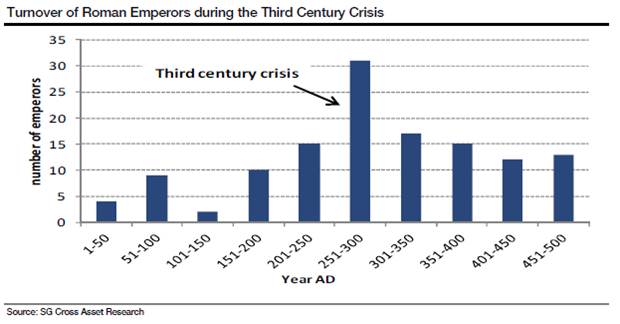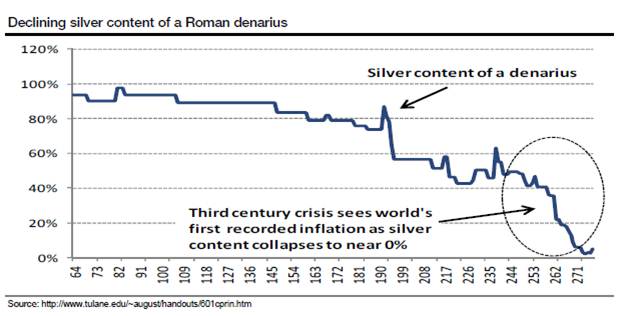|
— Introduction on Currency Debasement and Inflation
> Roman Times
— Medieval Ages and the French Revolution
— German Hyperinflation
— 1970s to Today
History is replete with Great Disorders in which currency debasement has coincided with social infighting and scapegoating. I have written in the past about the Roman inflation of the Third Century AD. The following chart shows the rapid turnover of emperors during what is known as the Third Century Crisis. As trade declined, crops failed and the military suffered what must have seemed like constant defeat, it wasn.t difficult for a successful or even popular general to convince the rest of the empire that he.d make a better fist of governing.

But this political turnover was accompanied by what may be history.s first recorded instance of systematic currency debasement. With the empire no longer expanding and barbarians being forced westwards by the migrations of the Steppe peoples, Rome.s borders were under threat. But the money required to fund defence wasn.t there. Successive emperors therefore reached the same conclusions that kings, princes, tyrants and democratically elected governments would later reach down the ages when faced with a perceived .shortage of money.: they created more by debasing the existing stock. In the second half of the third century, the silver content of a denarius had shrunk to zero. Copper coins disappeared altogether.
This debasement of currency also coincided with a debasement of society. Factions grew more suspicious of one another. Communities fragmented. And one part of the community bore the brunt of the fears: Christians. While Rome had always welcomed new religions and Gods, incorporating new foreign deities as their empire grew, Christians were altogether different. They rejected Rome.s gods. They refused to pray to them. They said that only their God was deserving of worship. The rest of the Romans concluded that this obstinacy must be a source of great anger for their own ancient Roman gods, and supposed that those gods must now be exacting their own great punishment in return.

So the Romans turned on their Christians with a great violence which lasted throughout the period of the currency debasement but peaked with Diocletian.s edict of 303 AD. The edict decreed, among other things, that Christian meeting places be destroyed, Christians holding office be stripped of that office, Christian freedmen be made slaves once more and all scriptures be destroyed. Diocletian.s earlier edict, of 301 AD, sought to regulate prices and set out punishments for .profiteers. whose prices deviated from those set out in the edict.
|